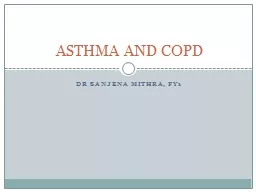PPT-Dr sanjena
Author : conchita-marotz | Published Date : 2016-02-28
Mithra fy1 ASTHMA AND COPD Objectives Differentiate severity of acute asthma exacerbations Pathophysiology of Asthma and COPD Discuss CXR and ABG Type 1 vs Type
Presentation Embed Code
Download Presentation
Download Presentation The PPT/PDF document "Dr sanjena" is the property of its rightful owner. Permission is granted to download and print the materials on this website for personal, non-commercial use only, and to display it on your personal computer provided you do not modify the materials and that you retain all copyright notices contained in the materials. By downloading content from our website, you accept the terms of this agreement.
Dr sanjena: Transcript
Mithra fy1 ASTHMA AND COPD Objectives Differentiate severity of acute asthma exacerbations Pathophysiology of Asthma and COPD Discuss CXR and ABG Type 1 vs Type 2 respiratory failure.
Download Document
Here is the link to download the presentation.
"Dr sanjena"The content belongs to its owner. You may download and print it for personal use, without modification, and keep all copyright notices. By downloading, you agree to these terms.
Related Documents

